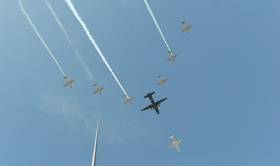Displaying items by tag: From Helga to Beckett
#Navy@1916 – Representing the Naval Service at the 1916 Easter Rising centenary parade held in Dublin were personnel from the navy and a related fishery patrol aircraft, writes Jehan Ashmore.
In a rare Air Corps Fleet Fly Past display totalling 17 aircraft, this included the largest aircraft, a Casa CN 325 Maritime Fisheries Patrol craft.
The fly-over of the capital’s main thoroughfare of O’Connell Street, is where the General Post Office (the G.P.O.) in 1916 formed the headquarters of the rising and was too the focal point of Easter Sunday's historic State centenary commemoration.
The blue painted Casa aircraft, in which there are two, works in close conjunction with the Naval Service to provide an aerial platform for patrolling the Irish Economic Zone. The area of this zone is approximately 132,000 square miles or 16% of the total EU sea fisheries.
Also in the capital over the Easter weekend were docked the Naval Service coastal patrol vessel, CPV LÉ Ciara along with the larger offshore patrol vessel, OPV LÉ Samuel Beckett. Both vessels had arrived on the Good Friday and were opened to the public to visit.
The pair were berthed at Sir John Rogersons Quay, where almost a hundred years this stretch of the Liffey water saw HMY Helga shell key rebel positions during the rising. The Kingstown (Dun Laoghaire) Harbour based vessel that was dispatched to Dublin, would later became the Irish Free State’s fishery research vessel Muirchu and also a career in the fledging navy as the LÉ Muirchu.
Easter Sunday’s parade involved more than 3,700 personnel from the Defence Forces including the Army and Emergency Services and respectively involving 78 vehicles. Among those marching were military bands and colourful flag parties. On that note lifeboat crew members representing stations nationwide of the RNLI were accompanied by a trailer-towed new Atlantic 85 lifeboat.
Returning to vessels on the water, it was the LÉ Ciara that was first to return to patrol duties following the conclusion of the parade.
The leadship of the current batch of ‘Beckett’ OPV90 class vessels along with LÉ James Joyce is to be joined by a third and final sister, LÉ William Butler Yeats which was floated-out of a UK shipyard hall before St. Patrick’s Day. At that stage the OPV was without a mainmast which can be seen (see photo) at the fitting-out quay of Babcock Marine & Technology located in Appledore, north Devon.





























































